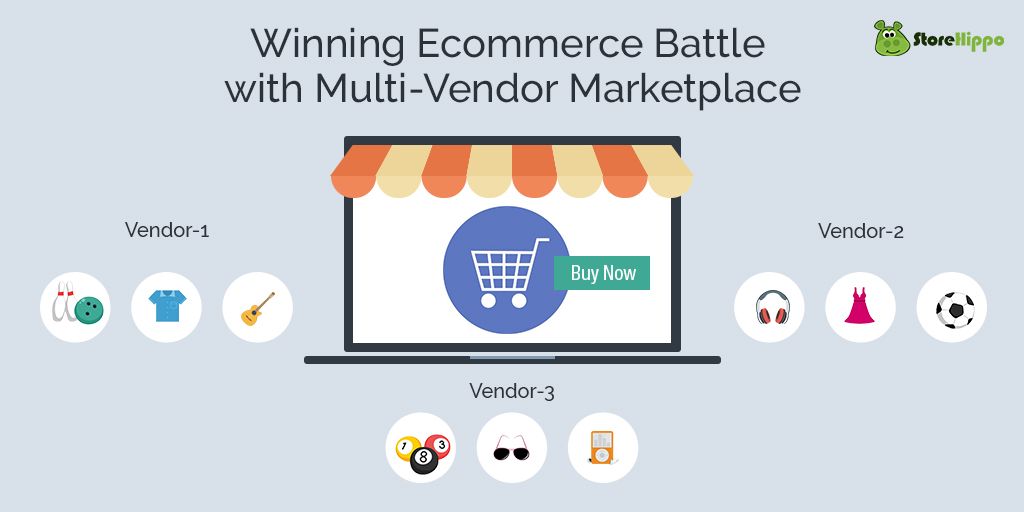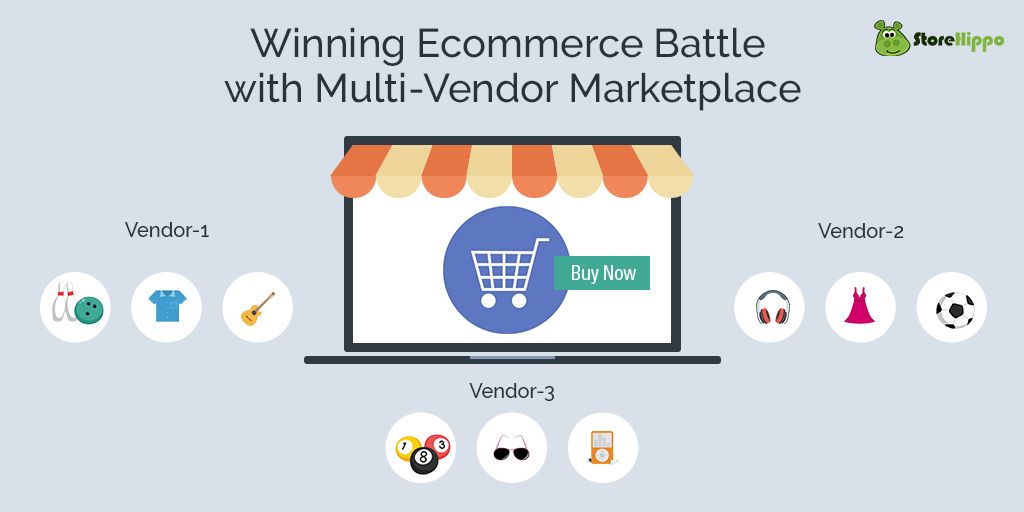If you list down the top 10 most successful ecommerce businesses, you will be surprised to find that an overwhelming 70% of them use the multi-vendor marketplace model. Analyze further and you would find that the remaining 30% also incorporate the multi-seller ecommerce approach in varying degrees.
From driving millions and even billions of traffic to engaging and retaining customers for a lifetime, multi vendor ecommerce marketplaces like Amazon, Alibaba, eBay, Rakuten, Shein, etc. have firmly established their dominance in the ever-evolving ecommerce landscape.
Wonder what drives customers in droves to these multi seller portals?
Here are the reasons:
Why customers love shopping on Multi-Vendor Marketplaces
- Rich product catalogs
- One-stop shop for diverse needs
- Ease of shopping
- Competitive pricing
- Trust in marketplace brand
Well, when customers get these many benefits they are definitely going to love your business and keep coming back to make your brand successful.
To better understand why building a multi vendor ecommerce website is your ticket to success, let us first start from the very beginning and understand the online marketplace business model, its types, benefits and how to build your own multi seller website in no time.
Table of Contents
- What is a Multi-Vendor Marketplace
- How does a Multi-Vendor Marketplace work
- Types of Multi-Vendor Ecommerce Setup
- Why Enterprise Brands should consider the marketplace model
- How to start a Multi-Vendor Ecommerce Website
- How to identify the right multi-vendor marketplace platform for your business
- How to promote your Multi-Vendor Marketplace
- Conclusion
What is a Multi-Vendor Marketplace
A multi-vendor marketplace is an ecommerce setup where multiple vendors come together on a single platform to sell different or the same products or services. This can be compared to a real-life mall where we see different shops selling a variety of different products or services.
Amazon, eBay, Flipkart etc. are some very popular examples of online marketplaces. The model is a virtual goldmine for entrepreneurs as well as enterprise brands as it ensures better business than a regular online store without any investment in inventory.
Different vendors selling a diverse range of products can be registered on a single multi vendor ecommerce website where they display and sell their products or services.
How does a Multi-Vendor Marketplace work
For each order that the sellers get on the marketplace portal, they pay a certain fixed or percentage-wise commission to the business owner(s). The marketplace administrators can also decide and implement other revenue models like vendor subscriptions, ad placement on the website, prime positioning of products, special promotions for the vendor’s products etc. to multiply their revenue.
The Vendors selling through the multi vendor ecommerce website do not need to invest in website development or maintenance under this setup. Sellers can just focus on running their business and can benefit from the large traffic volume of such multi seller platforms.
An ecommerce marketplace website attracts more customers and gets higher conversions as customers love the variety of products and the competitive prices offered by different vendors.
The multi-vendor marketplace is a WIN-ALL ecommerce model where the business owner, vendors and customers all get a better deal when compared to a simple online store.
Here are some insights into how customers love shopping on marketplace websites:
Shopping insights on Multi Vendor Marketplace Websites
- 48% of ecommerce buyers go straight to an online marketplace
- 47% of ecommerce buying worldwide happened via online marketplace platforms
- 14% of buyers go to an online marketplace for a first-time purchase
- 37% of customers prefer to make a repeat buy at a multi vendor ecommerce website
Source: Statista
With customers loving the multi seller business model, building a marketplace for your enterprise brand can be a lucrative business idea worth pursuing.
Types of Multi-Vendor Ecommerce Setup
The best thing about a multi-vendor store is that you can work out a variety of use cases and even come up with a disruptive model of your own. Some of the popular and time-tested use cases of a multi-seller ecommerce website are;
Types of multi-vendor marketplace websites
Niche Vertical Marketplace
This e-commerce setup targets a specific audience segment by offering a single niche product or service category. By creating this type of marketplace an etailer can get the undivided attention of the target audience and create a brand value in the given category. Multi-vendor ecommerce marketplaces for beauty products, health and fitness, apparel etc come under this category.
Example: Nykaa, Firstcry etc.
Horizontal Marketplace
This setup can be used for B2B or B2C model where products and services from a variety of business verticals are sold on a single platform by multiple sellers. This setup is the most common and also the most popular form of an online marketplace. Such online shopping hubs usually enjoy very good traffic as they have something for every buyer.
Example: Amazon, Flipkart etc.
Service Aggregation Marketplaces (B2B2C)
This marketplace setup has gained much popularity of late thanks to the popular food delivery and entertainment show booking platforms. Under this multi-vendor ecommerce setup, various vendors come together on a single platform to offer products and services to a wider customer base. The business owner earns by commissions and the vendors are able to reach a wider audience base.
Example: Swiggy, Zomato, Urban Company
Hybrid Marketplace
A hybrid marketplace is a marketplace website that targets both B2B and B2C audiences and combines multi vendor features along with some other popular models to create a unique marketplace.
Example: A pharmacy marketplace can have two or three separate sub-stores catering to end customers(B2C), big hospitals (B2B) and end customers of big hospitals (B2B2C). Such hybrid business models give enterprise brands the opportunity to cater to a wide audience base.
Hyperlocal Marketplace
Hyperlocal marketplaces have become very popular in recent times as they offer quick deliveries in a short time span for customers in a small geography. Enterprise brands can build successful hyperlocal multi-vendor marketplaces by onboarding local sellers as their vendors.
Example: Blinkit, Zepto etc.
With so many models to experiment with, the multi vendor ecommerce set-up is an ideal tool in the hands of enterprises planning to grow their business quickly and without investing too much in CapEX or inventory.
Why Enterprise Brands should consider the marketplace model
The multi-vendor ecommerce model has obvious advantages for enterprise brands. The multi seller enables the brands to manage their seller-dealer networks better and also helps in creating new revenue sources by the inherent nature of the marketplace set-up.
Here is why brands should pivot to the multi-vendor marketplace model:
- Easy to grow to new markets by adding new sellers
- No major upfront cost in setting up warehouses or inventory
- Easy to scale up the business by adding new products and sellers
- Freedom from managing products, orders, shipment etc.
- Easy commissions on every order
- Add more revenue streams like premium membership for buyers, subscription from sellers, ads, paid product positioning, tie-up with logistics partners etc.
- Gain the trust of customers who become loyal thanks to a rich catalog of products
- Accumulate rich customer buying and behavior based data to build strategic growth plans
Though building a multi vendor ecommerce website is more complex than an online store, by powering the business using the right ecommerce platform you can set your business on the path of success and growth. The whole setup also cuts the cost for the vendors as well as the store owners by distinctly dividing the roles and responsibilities.
A multi-vendor marketplace virtually sets up multiple smaller shops within your shop. This in turn, engages the customers in on-site comparisons between vendors and minimizes abandoned carts and competitor website hopping.
How to start a Multi-Vendor Ecommerce Website
So, the undisputed advantages of the marketplace setup are tempting, aren't they? Are you convinced to upgrade your website and convert it into a multi-seller ecommerce store?
Good decision indeed! But how do you plan to achieve this?
There are obviously two ways to go about it. Either build the whole set up from scratch or opt for a tested turnkey marketplace solution. While building your multi vendor ecommerce store from scratch can be time, resource and cost intensive a turnkey solution might be rigid and not give you the flexibility to tweak the platform according to your requirements.
So what is the solution to this Catch 22 scenario?
Can you find a seamless, robust and reliable multi-vendor solution that enables you to roll-out your marketplace in a hassle-free manner?
Well yes, you can do that if you research and make an informed decision while selecting your marketplace solution provider.
How to identify the right multi-vendor marketplace platform for your business
What if you can combine the best of the two approaches i.e, you get a turnkey solution that is easy to be customized and allows you to make changes according to your unique requirements? You need a platform that has been designed to accommodate the various use cases and gives you the flexibility to implement your unique business requirements.
Here is what you should be looking for in your multi vendor ecommerce solution:
- Ability to mold the platform inside out for building your unique business solutions
- Future-ready, hosted and managed solutions
- Built-in tools and solutions to build mobile apps
- Ability to add new customer touchpoints quickly
- Scalability to accommodate business expansion and growth
- Built-in features to run the everyday business smoothly
- Easy vendor management and payout solutions
- Smooth learning curve for vendors so they manage and run business effortlessly
- Seamless integrations with preferred third party providers and software
- Inbuilt marketing solutions for strategic growth hacking
- Transparent pricing and post-sales support
If you get all of the above in your multi vendor ecommerce platform, go for it and build your online marketplace to grow your business.
StoreHippo multi vendor ecommerce solution has been built on MACH (Microservices, API-first, Cloud-native Headless ) architecture that gives your enterprise brand creative freedom and flexibility to create a tailored ecommerce ecosystem for your business.
With 300+ built-in features and 120+ pre-integrated solutions, StoreHippo offers a plug-and-play ecommerce solution that can be used by businesses of every scale and size. The comprehensive multi vendor solution from StoreHippo makes building, running and growing your marketplace an effortless business experience.
Built on mobile first principle StoreHippo comes with an inbuilt mobile apps builder to build Android and iOS marketplace apps. All multi-vendor marketplace websites built on StoreHippo are PWAs, which means they look and feel like mobile apps when opened in a browser.
StoreHippo also has built-in support for a variety of ecommerce business models like B2C, B2B, D2C, B2B2C, multi-store ecommerce, hyperlocal ecommerce, multilingual and multi-currency solutions etc.
StoreHippo multi vendor ecommerce solutions have been tested in real-time with live and successful projects across business verticals using different business models.
How to promote your Multi-Vendor Marketplace
Building a future-ready online marketplace can be taken care of by powering your business with StoreHippo. However, to grow your marketplace website you would need a sound, multi-pronged growth strategy.
Here are a few tried and tested tips you can replicate to create interest in your business, engage your buyers and convert them easily.
- Generate interest in your multi-vendor marketplace by building a “coming soon” page and promoting your brand across digital social platforms
- Give early bird discounts and coupons to start getting initial orders on your multi-vendor website
- Give referral bonus to your existing customers so they bring more buyers by word of mouth promotion
- Offer value added services to keep customers coming back
- Design premium membership plans to incentivize customers for buying more
- Use your customer base to attract and onboard new vendors
- Implement vendor-friendly policies to help your vendors grow their business
- Leverage social media platforms to engage buyers and build a strong follower community
By implementing these strategies, you can effectively promote your multi-vendor marketplace website and witness a steady influx of customers to your business.
Conclusion
Multi-seller marketplace enables brands to capture a bigger market and thus earn better ROI. The versatility of the model makes it the perfect choice for implementing across diverse industries. Thanks to the no upfront inventory and warehousing costs, building a multi vendor ecommerce website is easy for your brand.
All you need is a user-friendly and next-gen multi vendor solution like StoreHippo to power your business. Built on headless architecture StoreHippo enables you to build tailored multi vendor ecommerce websites and personalized buyer journeys easily.
Need to check the functionality live before you roll out your own multi-vendor marketplace?
Book a demo right away and one of our representatives will take you through the platform and its advantages.





















2 Comments
Leave a Reply
Leave a Reply